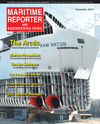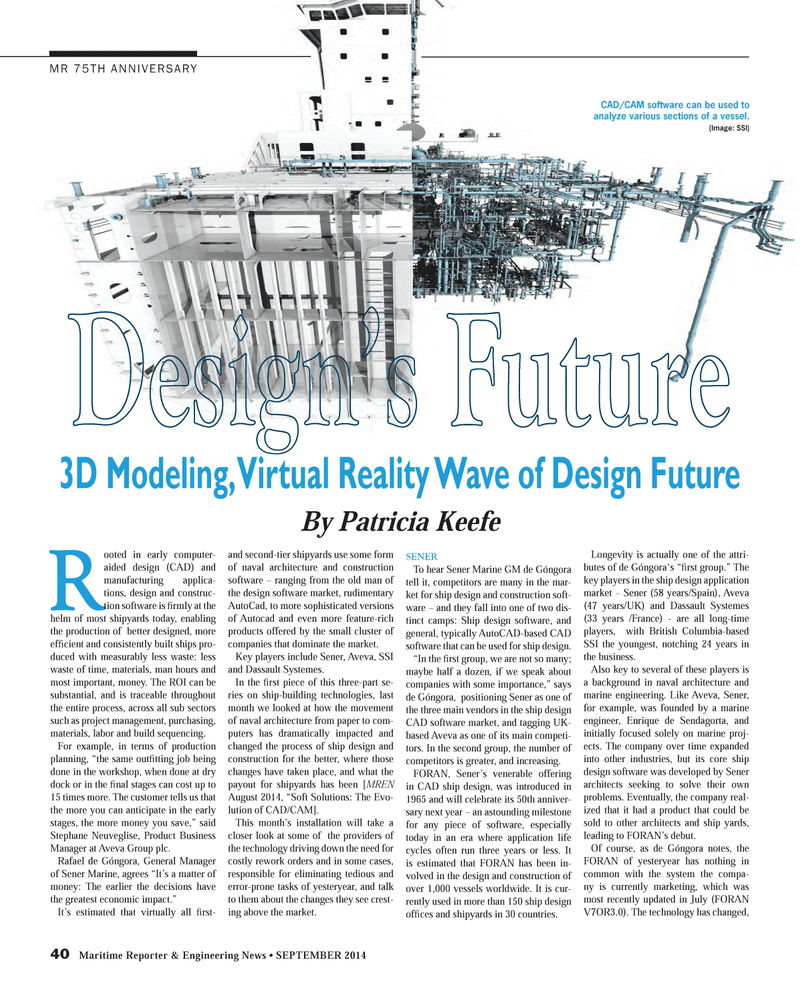
Page 40: of Maritime Reporter Magazine (September 2014)
Marine Propulsion Edition
Read this page in Pdf, Flash or Html5 edition of September 2014 Maritime Reporter Magazine
40 Maritime Reporter & Engineering News • SEPTEMBER 2014
MR 75TH ANNIVERSARY
R ooted in early computer- aided design (CAD) and manufacturing applica- tions, design and construc- tion software is fi rmly at the helm of most shipyards today, enabling the production of better designed, more effi cient and consistently built ships pro- duced with measurably less waste: less waste of time, materials, man hours and most important, money. The ROI can be substantial, and is traceable throughout the entire process, across all sub sectors such as project management, purchasing, materials, labor and build sequencing.
For example, in terms of production planning, “the same outfi tting job being done in the workshop, when done at dry dock or in the fi nal stages can cost up to 15 times more. The customer tells us that the more you can anticipate in the early stages, the more money you save,” said
Stephane Neuveglise, Product Business
Manager at Aveva Group plc.
Rafael de Góngora, General Manager of Sener Marine, agrees “It’s a matter of money: The earlier the decisions have the greatest economic impact.”
It’s estimated that virtually all fi rst- and second-tier shipyards use some form of naval architecture and construction software – ranging from the old man of the design software market, rudimentary
AutoCad, to more sophisticated versions of Autocad and even more feature-rich products offered by the small cluster of companies that dominate the market.
Key players include Sener, Aveva, SSI and Dassault Systemes.
In the fi rst piece of this three-part se- ries on ship-building technologies, last month we looked at how the movement of naval architecture from paper to com- puters has dramatically impacted and changed the process of ship design and construction for the better, where those changes have taken place, and what the payout for shipyards has been [MREN
August 2014, “Soft Solutions: The Evo- lution of CAD/CAM].
This month’s installation will take a closer look at some of the providers of the technology driving down the need for costly rework orders and in some cases, responsible for eliminating tedious and error-prone tasks of yesteryear, and talk to them about the changes they see crest- ing above the market.
SENER
To hear Sener Marine GM de Góngora tell it, competitors are many in the mar- ket for ship design and construction soft- ware – and they fall into one of two dis- tinct camps: Ship design software, and general, typically AutoCAD-based CAD software that can be used for ship design. “In the fi rst group, we are not so many; maybe half a dozen, if we speak about companies with some importance,” says de Góngora, positioning Sener as one of the three main vendors in the ship design
CAD software market, and tagging UK- based Aveva as one of its main competi- tors. In the second group, the number of competitors is greater, and increasing.
FORAN, Sener’s venerable offering in CAD ship design, was introduced in 1965 and will celebrate its 50th anniver- sary next year – an astounding milestone for any piece of software, especially today in an era where application life cycles often run three years or less. It is estimated that FORAN has been in- volved in the design and construction of over 1,000 vessels worldwide. It is cur- rently used in more than 150 ship design offi ces and shipyards in 30 countries.
Longevity is actually one of the attri- butes of de Góngora‘s “fi rst group.” The key players in the ship design application market – Sener (58 years/Spain), Aveva (47 years/UK) and Dassault Systemes (33 years /France) - are all long-time players, with British Columbia-based
SSI the youngest, notching 24 years in the business.
Also key to several of these players is a background in naval architecture and marine engineering. Like Aveva, Sener, for example, was founded by a marine engineer, Enrique de Sendagorta, and initially focused solely on marine proj- ects. The company over time expanded into other industries, but its core ship design software was developed by Sener architects seeking to solve their own problems. Eventually, the company real- ized that it had a product that could be sold to other architects and ship yards, leading to FORAN’s debut.
Of course, as de Góngora notes, the
FORAN of yesteryear has nothing in common with the system the compa- ny is currently marketing, which was most recently updated in July (FORAN
V7OR3.0). The technology has changed,
By Patricia Keefe
CAD/CAM software can be used to analyze various sections of a vessel. (Image: SSI) 3D Modeling, Virtual Reality Wave of Design Future
MR #9 (40-49).indd 40 9/4/2014 10:48:22 AM

 39
39

 41
41
